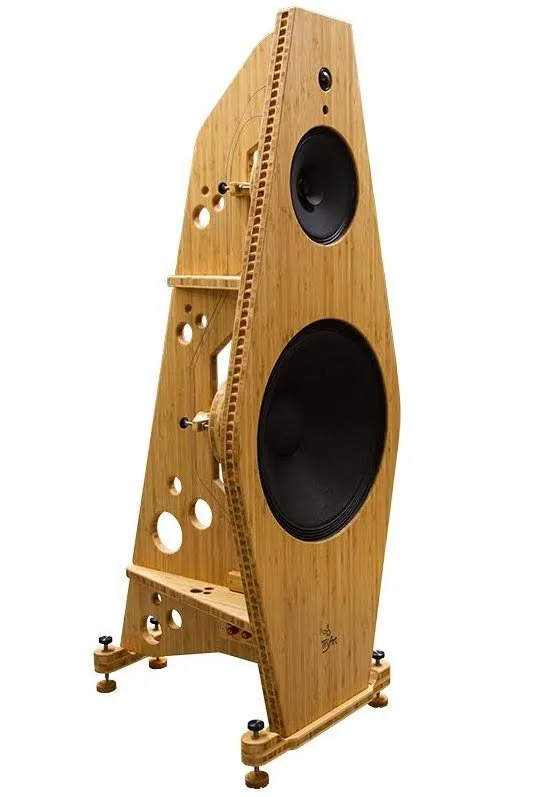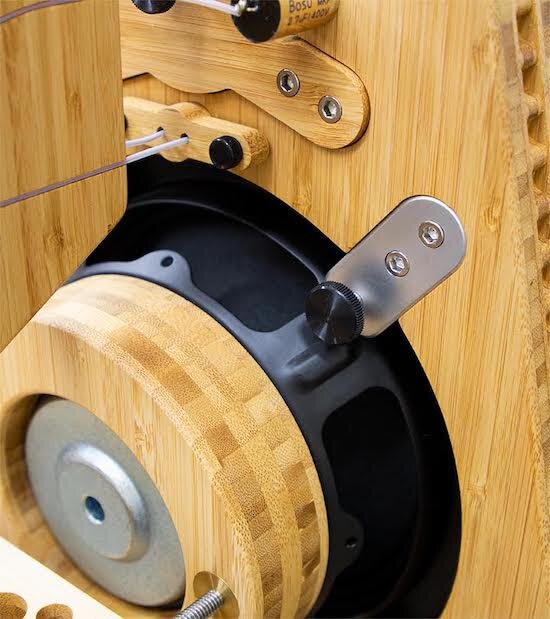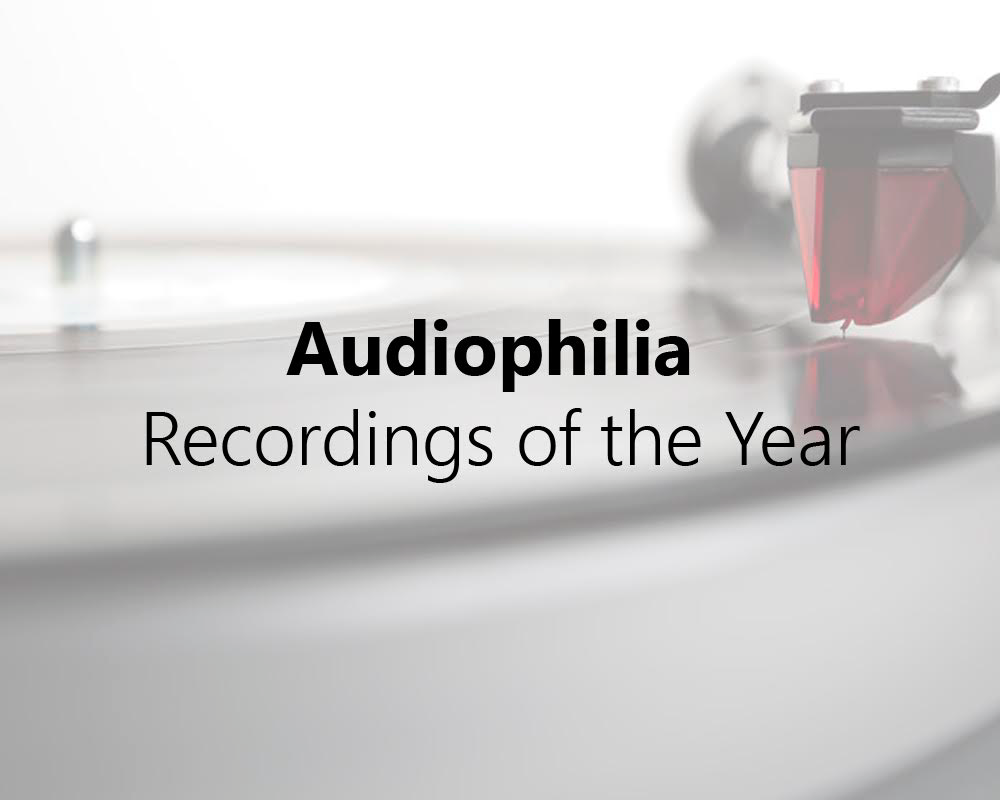Tri-Art Audio B Series 4 Open Speaker
Down the ribbon of highway, due east from the frenetically paced GTA (Greater Toronto Area), lies the somnolent university town of Kingston, Ontario. Queen’s University, as an intellectual hub of all eastern Ontario, has been the centre of Kingston’s relevance for a century. But if one looks past this well established landmark, one finds a business of some significance that has been quietly sounding out its audio relevance for the last 10 years—Tri-Art Audio.
Arising out of the ashes of the great stereo retail shop of the 1970s and 80s, House of Sound, where Steve Ginsberg worked as a technician—that wonderful bricks and mortar place penurious Queen’s students like myself hung around in the few moments we had free—has come Steve’s and his sons, Simon and Evan’s extraordinary business adventure—a quality international seller of fantastically sophisticated paints and some of the hippest audio equipment on the planet—the fabulous jewel of Tri-Art Audio. A fantastically interesting business anomaly—paint and sound!
The business acumen of Ginsbergs has created a unique business trinity of a global producer of screen projection paint, interestingly called, Goo Systems; Tri-Art art supplies, a leading Canadian supplier of high-quality acrylic paints; and the amazing and unique final part of the Ginsberg Trinity, Tri-Art Audio. Who can pull this type of business model off? Apparently, these guys can.
As soon as I heard about these Canadian speakers from Tri-Art, I asked my editor to see what he could do about Audiophilia reviewing them. So, in the middle of just this past August, Steve Ginsberg and Jim Leveille (Marketing & Sales) drive down that ribbon of highway into the GTA, deliver and set up the visually stunning B Series 4 Open Baffle Speakers with its outboard crossover in my man-cave, with a courtesy and grace that reminds me of ‘haut-concierge’ service—something I can never afford—and hook these stunning speakers up to the Tri-Art Audio B series 60 Watt-S Integrated Amplifier (my review forthcoming).
I’d like to thank Steve Ginsberg, Tri-Art Audio’s Founder & Designer, and Jim Leveille, Tri-Art Audio’s Sales and Marketing Manager for their kind considerations.
A special thank you, also, to Angie Lisi of American Sound of Canada here in Toronto for her kindness, generosity and patience improving my vinyl game to aid in this review—Sutherland Engineering KC Vibe Mk2 ($895; review forthcoming) and Shelter Model 501 III MC Phono Cartridge ($1295).
The price of the B Series 4 Open with its external crossover (photo below) is $3,840.
Delivery, setup & a little background
Their pride in their equipment is palpable and Steve is very exacting in his placement of his speakers out from the main wall—approximately 3 to 4 feet. We’ll talk about why this is essential for ‘open baffle’ speakers a little later.
I put on Miles Davis’ Kind of Blue,’ my Legacy Vinyl baby, and even at this early stage of the speakers, there is a unique transparency of sound hitting my ears. We all agree, the speakers are in the sweet spot and with many thanks the boys are off and I begin my journey with the Series 4.
Before we get to the meat and potatoes, I need to say a few things about speakers in general and ‘open baffle speakers in particular. I know the readers of Audiophilia are amongst the most sophisticated audiophiles out there and much of what I will say is well known, but let this reviewer set a little background for all of our readers.
Let’s face it the overwhelming number of speakers produced globally are the traditional ‘box’ speakers. Open baffle speakers are still an anomaly, but their numbers are slowly growing. Will they ever reach in numbers, the more traditional design? My guess is they will. But what we do know for sure is the very clear acoustical and wave engineering differences that come with the open baffle design.
The age old difficulty of all speakers, regardless of the design—box, horn, open baffle—is your domestic space—what Clayton Shaw, the owner of Spatial Audio, another producer of open baffle speakers says, “...the room, is the elephant in the room!” Why? Because no manufacturer can possibly take into account the number of permutations and variations in the consumer’s audio space. What is the height of the ceiling?; what kind of material is used for flooring?; what’s the length of space from the speaker to the listener?; is the room L-shaped?; how close are the speakers to the right angle walls?; what is the distance from speakers to the back or side walls?; are there any architectural breaks in the room that can deflect the air waves?—and it goes on and on. Does this matter? In many small ways, added cumulatively, they can and will. All of these ‘material’ and ‘spatial’ realities will affect the sound from the speaker in your domestic space.
So, if your room size/shape is a significant factor in what you are hearing through your system, a more fundamental question becomes: Is there a way designers and manufacturers can mitigate the way speakers, in or out of a box, radiate energy out into a room, with all of these other variables at large? Well, that’s a huge question that involves design, materials, crossovers, attenuators, the complex interactions of all the stations throughout your system and the whole 9 yards. But at the simplest of levels, of your 3 speaker ranges, woofer, mid-range and tweeter, the woofer poses the greatest problem in small rooms. Why? Because the bass wavelength is the longest wavelength and can produce its own pressure field effect. When a woofer responds to a signal it pressurizes the air. We get waves of sound from the moving diaphragm of the speaker. As the woofer pushes the air forward in the front of the speaker, it creates an antithetical movement of air in the back. In effect, you have higher air pressure in front, lower air pressure in back. Then, the opposite occurs. You get a back and forth movement of high and low pressure, or some call positive and negative pressure. But for one moment, you can get ‘nothing.’ You get ‘phase cancellation.’ This is why, traditionally, a box has been placed around the woofer, so the back wave does not cancel out the front wave.
Like everything in life, however, there are trade-offs—so, too, in audio science. When you put a box around the woofer you ostensibly create a more efficient use of the bass wave. But here is the trade-off. A big bass note from your box woofer can pressurize a domestic room creating what is called ‘room boom.’ That is, the impact and pressure wave from the bass note will cascade back from parts of the room, a form of recovery from that pressure, producing a ‘bleeding’ through of the bass frequencies into the mid and treble ranges, thereby, reducing the sonic clarity and independence of those ranges. Generally, bad news. A ‘muddy’ sound that lacks all clarity. Put those speakers in a very large room and that problem is reduced, or at least seriously diminished. But who has a very large audio room? Not me. And my guess most of you don’t, either.
In addition, the box speaker is a resonance system—it vibrates. Which can be a very powerful tool. It emits sound waves horizontally and vertically at every level of the box—top, front and 3 sides. Those sound waves, however, depending upon proximity to walls or ceilings, will create a type of interference. Why? Because these soundwaves are spreading out as I said earlier from 4 sides and the top in a small space rebounding off close walls and ceiling, where the linearity of the waves are diminished. These constructive or destructive interference patterns will either add to the signal or cancel the signal, creating either excessive, or scarce bass. So, the main reason one would contemplate the construction of an ‘open baffle’ speaker is to bring into your audio domestic space a speaker that will deliver, optimally—not absolutely—more of a ‘linear wave’ of sound with less cancellation and less frequency interference, less destructive interference patterns. Sounds good, so far. That’s the theory. And then, finally, when you remove the box, you remove the energies coming out of the sides and top of your speaker, ameliorating those competing destructive interference patterns. You create a more directional bass beam with a more forward sound, inviting less interference patterns. What is left is a ‘figure 8’ shape flow from your speaker, front and back and, in general, a more consistent broadcast pattern, far less contingent on the variables of the room. How many of us have spent an inordinate amount of time adjusting our box speakers to reduce a certain ‘muddiness’? Searching for the sweet spot. I suspect a large number of us. Ginsberg set up the B 4 Series speakers 3 and half feet out from the wall and adjusted them slightly. The acoustical design of the speakers took over from there—a practical solution to the sound problems of our individual domestic space.
My Use
I have fallen in love with bamboo. Who would have guessed? First glance at the Tri-Art audio equipment, including the B Series 4, displays the rarity and uniqueness of seeing bamboo for both amplifier casing and baffle material. Why? Well, it turns out bamboo, as a member of the grass family, Poaceae, is a natural composite material that has a high strength-to-weight ratio, similar to strong timber. Its growth trajectory is also insane. Depending on the subcategory of the Poaceae and where it grows in Asia, it can grow 910 mm (36 in) within a 24-hour period. You want to keep our old growth forests around, start using bamboo.
The very cool thing about Tri-Art’s use of bamboo for baffle material is not just the look, but its sonic character. Ginsberg has been quoted as saying bamboo was chosen first and foremost for its sound properties. Not only is it multi-dimensional in usage, but ‘...it is inherently a very fast material, that has an incredible isolation to both airborne and structural vibrations.’ His team believes bamboo brings a warm, natural environment to the music and in a world that is accustomed to the coldness of digital, they like to think of bamboo as ‘Mother Nature’s Carbon Fibre, speed without the dryness to the sound.’ Well, I’m on board.
Features
The speakers are dressed with a dome tweeter, a super tweeter, full range driver and a 15" sub bass driver. Two crossovers are supplied with attenuated drivers—this is optional with the B-Series 4; however, I imagine most folks would want the added crossovers to adjust the bass response to the uniqueness of their listening room. This is an absolute must and an addition that has proven to be a sonic gift [I spoke to Tri-Art about some confusion on my part regarding the photos and crossover choices on their website. They are considering updating the site—Ed].
Specifications
Nominal Impedance: 8Ω
Recommended Amplifiers: 25 Up to 150 Watts RMS
Sensitivity: 92 dB SPL
Volume Matching: Crossover Only
Frequency Range: 35 – 40,000 Hz (+/- 3dB)
Upper Drivers:
One 1″ Fabric Dome Tweeter (13,000 Hz and up)
One 8″ Full Range Paper Cone Cloth Edge
One Super Tweeter (40,000 Hz)
Bass Drivers:
One 15″ Paper Cone Cloth Edge Woofer
35-100Hz @ 1st Order 6dB Slope
Crossover Details (Optional)
Inputs: 2
Outputs: 2 (including a set of 0.5 meter jumper cables with banana plugs)
Output 1 (Full Range)
100 Watt Attenuator
47 Ohm Resistor
100 Hz Single Cap Filter
Output 2 (Bass)
Single open air inductor filter 100Hz @ 1st Order 6 dB Slope
Dimensions
H: 45″ (114.0cm) W: 15.6″ (39.5cm) D: 19.5″ (49.0cm) Weight: 12.1kgs (25.75lbs)
Crossover
H: 4.33″ (11.0cm) W: 10.0″ (25.0cm) D: 11.0″ (28.0cm) Weight: 3.8kgs (8.75lbs)
Sound
How do they sound? Let’s start with Zubin Mehta’s fantastic Decca recording of Mahler’s Symphony No. 2 with the Vienna Philharmonic Orchestra and the sublime Christa Ludwig on vinyl. Here’s a few key spots that highlight the ‘soundstaging’ and the overall sound these speakers bring. Side 3 begins, in essence, with the great horns calling offstage—the primal tonic to dominant. The off-stage presence of the horns is crystal clear and the midrange is transparent. This whole section leads to Ludwig’s beautiful and dark words, ‘O, Glaube.’ But so I do not get ahead of myself, we’ll back up to this much more sparsely orchestrated section, showing off Mahler’s brilliance as an orchestrator. The pizzicato strings with flute solo is vibrantly tangible. The strings I can reach out and touch and without exaggerating, even a little, the first time I listened to this section with the B-Series 4 I thought I could hear the natural throat tone change in the flute moving through a wide tessitura. Really, remarkable and utterly genuine. Even in some of the greater tutti sections there is a continuing clarity of detail. I hear no ‘bleeding’ of ranges throughout the overall sound. The vast choral ending is a perfect 3 dimensional revelation through 2 points of sound—utterly beautiful.
Next up is Gorecki’s Symphony No.3, Symphony of Sorrows, op.36; once again, on vinyl with the Polish National Radio Symphony Orchestra, Krzysztof Penderecki conducting and Beth Gibbons singing the soprano part. The Domino Recording Co. issued this performance in 2019 and the sound recording is excellent. For my part, however, there is no equal to Dawn Upshaw and David Zinman’s original 1992 recording on CD; and Beth Gibbon, a pop singer, is not a good fit for this part—most unfortunate. But the great opening of this symphony, this massive 24 bar Aeolian mode, 2 part canon, beginning on a low E in the double basses, is a huge test for speakers. Often enough, the opening has no coherence at all, as one strains to recognize what the hell is going on. Well, fear not. As I got ready to set my new Shelter Model 501 III cartridge into the labia-like grooves of the recording, I thought to myself, this will be the test. Yes, my new Sutherland KC Vibe Mk2 phono preamp will assist, but the speakers will have to carry the can on this one. I sat back and began to grin. This time, I didn’t sigh a huge sigh of relief when the cellos came in and the midrange took over from the mud of the opening—I could discern every note in the double bass opening! What was so remarkable, was how refreshingly ‘dry’ the bass was; how little overtone there was in the sound. How crisp, how dry—like a good Chablis!
The greatest, I mean the greatest, recording of Wagner’s Die Walkure, is Erich Leinsdorf’s recording with the London Symphony Orchestra, featuring Jon Vickers as Siegmund, Birgit Nillson as Brunnhilde, David Ward as Hunding and Gré Brouwenstijn as Sieglinde. This one’s on Decca CD. I wanted to throw this one in for our readers, not for any particular sound challenges, but because nothing stirs my blood more than hearing the opening of the opera, the great storm and Siegmund’s desperate flight, brought to life by an orchestra that could still throw caution to the wind. Driven by a great force—Leinsdorf. Listen to the raw opening. Speakers that sound with detail and clarity in the midrange, without any wave interference from the double basses will bring forth the fury of the tremolos like nobody’s business. The B-series 4 does it again. As the storm dissipates and Siegmund arrives on the stage, the descending double basses in sequence, come off sounding clear and dry with a perfect attack that one expects in this passage, but is rarely heard.
Miles Davis’ Kind of Blue, first cut, ‘So What’. Dry stand-up bass with crisp piano and ride cymbal, glistening as transfigured light, and air, air, and more air. Beautiful soundstaging, with sublime clarity. I leave the room with Miles playing, head upstairs and then walk back down 2 minutes later with a sense I’ve walked back into time and I’m eavesdropping on an intimate, historically significant live studio moment. Well, I have, haven’t I. The B-series 4 has delivered. What a beautiful presence, bringing a joy that watches and listens to sound floating in my little space. This has never happened. The only thing that’s missing is Miles and Bill.
Summary
Well, dear reader, I’m running out of vocabulary and this journey is coming to a close. But for me this has been a blast and one for which I will always be eternally grateful to Tri-Art Audio. The B-series 4 Open Baffle Speakers are a wonderfully impressive portal for superb sound, for imaging and soundstaging that should come from speakers 3 times Tri-Art’s $3,840 cost.
But you don’t have to spend an outrageous amount of money to achieve what we all want: the satisfaction of hearing 3 dimensional sound come through 2 points of light with a level of clarity, transparency that removes all sound fatigue. And if it is true that our brains, in listening to music, are constantly trying to match what we hear to our own understanding of the world, of humanity’s ability to create sound, then we need speakers that translate the source as authentically as possible. These speakers do this.
Further information: Tri-Art Audio







